If you’re looking to better organize and structure your marketing campaigns with Microsoft Teams templates, this blog post is for you! Here we will outline how templates can help you streamline your marketing process, what capabilities you’ll get and how to build a Marketing Campaign template from scratch. Let’s get started!
Why do you need a Microsoft Teams template for marketing campaign?
Structured marketing planning
To successfully manage marketing campaigns in Microsoft Teams the best practice is to create a dedicated team for each. This way, your team members will have a focused workspace with information related solely to the campaign they’re currently working.
At the same time, your marketing campaign teams should follow similar structure to bring consistency to the collaboration process and allow your employees to execute faster and in a more organizes way.
For that, you can leverage Microsoft Teams Collaboration templates. You will only need to create a Marketing Campaign team once, including private and standard channels, files and documents and tabs with apps. All the teams created from the template will clone its structure and all the content you added to the original team.
More coordinated and efficient collaboration
With Collaboration templates you can assign specific people as Permanent owners and members, thus making sure the right people will always be added to the teams created from the template. This will allow your team members to always stay up to date with each new project and get started immediately.
Additionally, they will have all the necessary resources and tools ready at place – such as template documents, guidelines, planner, and various apps already pre-configured, enabling your team to work together more efficiently.
Faster execution
Having a clear team structure with all the channels that represent different topics of collaboration, and all the content necessary for successful implementation of a marketing campaign, saves your team members quite a bit of time that they can spend on campaign execution. Additionally, with a ready-to-go team your employees will have a clear idea about where they need to start and proceed, increasing their effectiveness and thus allowing to execute faster.
Advanced Microsoft Teams template capabilities
What will you get?
Focused discussions via channels
You may want your Marketing Campaign teams to have similar channels to add consistency and better organize collaborative work of your marketing team.
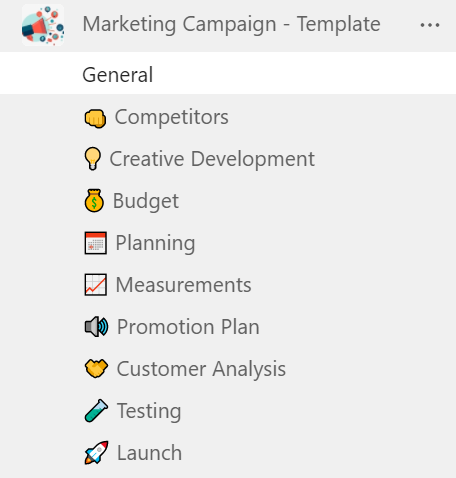
For that, you can create channels at the template level that will represent different stages of your marketing campaigns as well as topics that your marketing team most frequently discuss when they work. You can use the following channel names as an example:
- Planning
- Creative Development
- Promotion Plan
- Testing
- Measurements
- Launch
- Budget
- Competitors
- Customer Analysis
Improved file management system
You may also consider uploading files and documents that can be helpful for your teams in executing marketing campaigns. That can be campaign plan templates, email templates, list of useful resources, guidelines, materials from previous campaigns, etc.
Upload your files to respective channels and pin the most important ones as tabs, if needed.
If you have a SharePoint site where you keep all your marketing documentation, you may also want to add as a tab so that your marketing teams could have a fast and easy access to it. Additionally, you can create your own intranet through SharePoint where you can post latest news and updates, share important documentation, or create guidelines. This can be an organization-wide site or one that is exclusive to your marketers.
Learn about best practices for file management in Microsoft Teams.
Better time management with pre-built tasks in Planner
To successfully manage your marketing campaigns, you can provide your team with already pre-built tasks that will repeat from one campaign to another. This way, they will have a clear understanding of where they should get started, distribute tasks accordingly among team members and, consequently, deliver much faster.
You can achieve that by building tasks for your marketing campaigns in Planner. Then, add it as a tab in Planning channel of the original team on which you’ll base your template. With Planner you can separate your tasks into distinct categories or buckets, add checklists, attach files and links, set up priority levels and assign tasks to different team members.
Then, whenever a new team is created from your Marketing Campaign template, all the tasks that you added at the template level will be automatically copied to it. Afterwards you can customize it further according to the needs of each campaign.

More connected employees with Yammer communities
If you work in a large enterprise with branches in multiple locations, you may want to use Yammer communities to connect your employees who live miles away from each other. You can create a Marketing community where all the marketers across your organizations could join to share their experience and knowledge, ask questions, and give their expert opinion on specific matters.
Just Pin your Yammer community as a tab in a relevant channel. It will be copied to all new teams created from the template.

Campaign assessment with Power BI
You may also want to leverage Power BI analytics tool to assess your marketing campaigns, identify consumer insights and measure your marketing efforts. Similarly to other Microsoft apps, you can integrate it with Teams and add it as a tab. This way, your team members could create reports together, comment and exchange ideas, and share them in Teams channels. Power BI also allows you to build reports based on the data from your Google Analytics, allowing you to analyze data without living your collaboration workspace.
These are by far not the only tools you’ll get with Collaboration templates. Whatever app your teams most frequently use, you can pre-configure it and add as a tab so that your marketers can start collaborating on a new campaign straight away.

Answering IT needs
Aligned team naming
You can set up naming rules for your Marketing Campaign teams at the template level. This way, you keep your tenant organize and facilitate navigation through all the teams you’re a member of.
You can choose a static or dynamic Naming convention based on Azure AD attributes.
For example, it can be:
Marketing Campaign – Name of the campaign, or
Marketing Campaign – Name of the campaign – User location
Where user location will change depending on where the user who’s creating the team is located. If they’re located in LA, you can look like that:
Marketing Campaign – Contoso – LA or Marketing Campaign – Contoso – USA, depending on the configurations you choose.
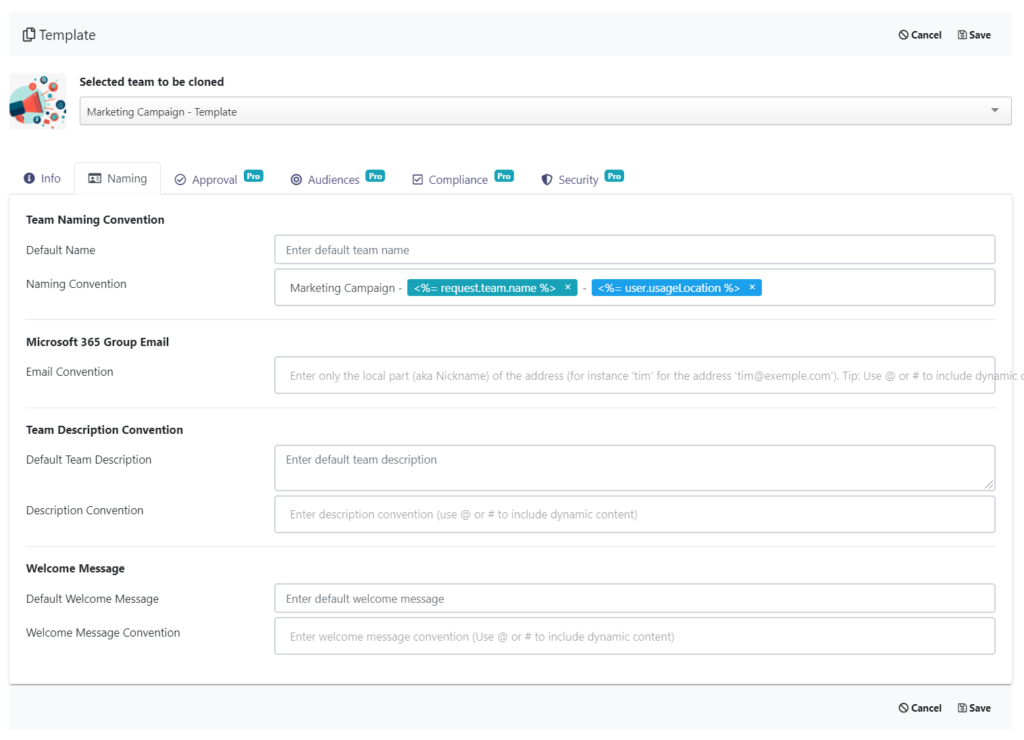
Control over team creation
With Microsoft Teams Collaboration templates, you can control the team creation process without hindering the end-user experience. For example, you can set up Audience targeting. By enabling this capability, you will decide which groups of people in your organizations can see and access your template. This way, you may decide to make the template visible only to people in your marketing department.
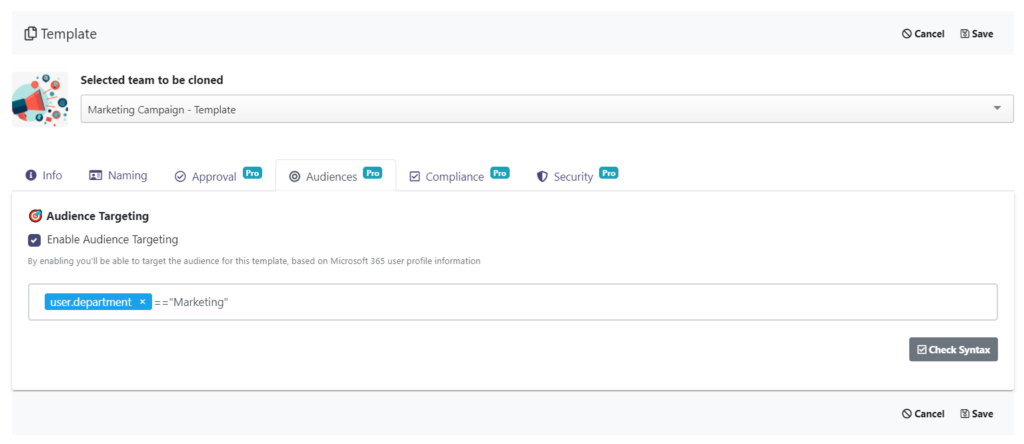
Another option is to set up and Approval workflow. You can assign a specific person or people, such as your marketing manager, to be an approver for this template. So, whenever anyone is creating a team from the Marketing Campaign template, they’ll first need to send a request and receive an approval.
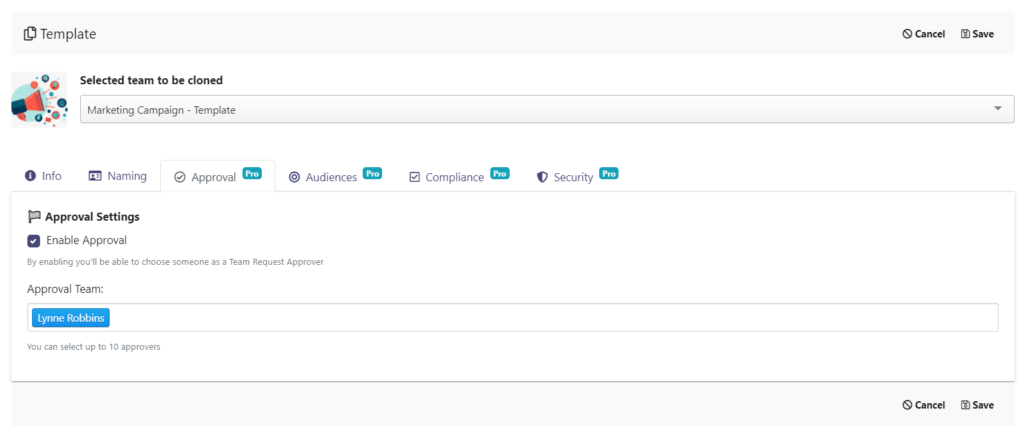
These capabilities will help increase security of your teams and prevent Teams sprawl.
Membership policies
You can also make sure the right people are immediately involved in a new marketing campaign by setting up membership policies. You can assign specific people to be Permanent owners and members of each team created from this template. Whenever a new Marketing Campaign team is created, they’ll be added automatically on a permanent basis.
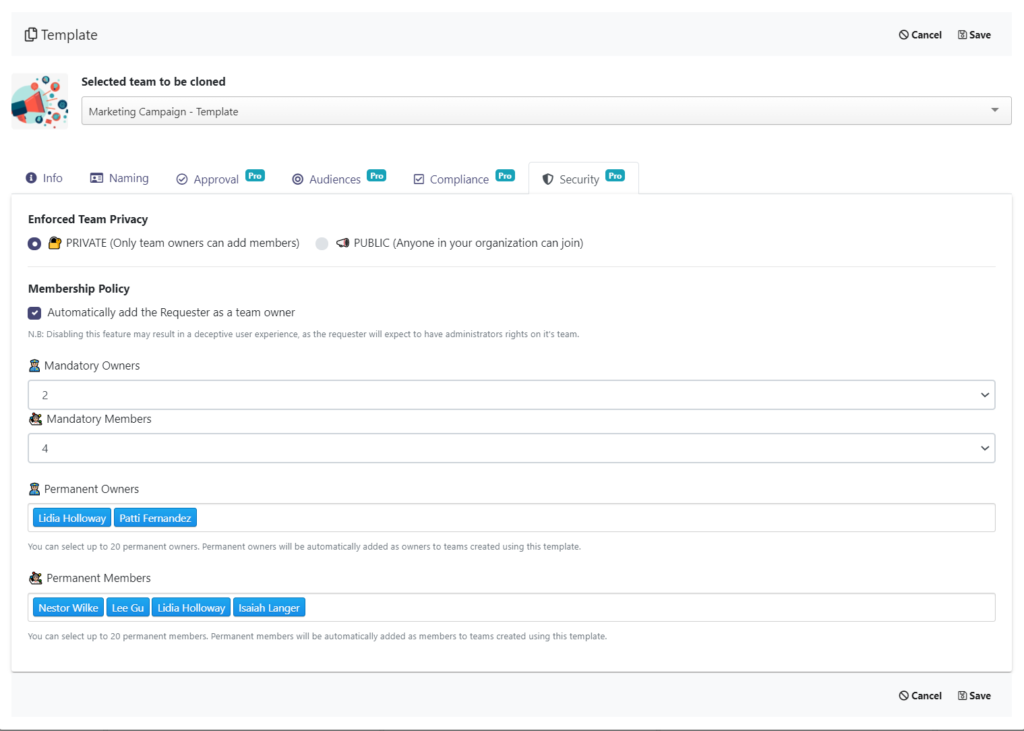
How to build a Marketing Campaign Microsoft Teams template?
To build a Microsoft Teams Collaboration template for marketing campaigns you’ll need to install nBold from Microsoft Teams store. Note that you must have admin right to manage the app.
Then you should follow these steps:
- Create an Original team on which you’ll base your template and call it Marketing Campaign – Template for easier navigation.
2. Add all the content that your future teams will require: private and standard channels, files and folder, tabs with apps.
3. Head over to nBold tab on the left bar of your Teams environment and click on Catalog > +New template.

4. Type the name of your original team: Marketing Campaign – Template. After selecting it, you’ll need to configure governance policies according to your organizational needs.
5. Set up a Naming convention, Approval workflow, Audience targeting, and Security policies with Permanent owners and members.
6. Save your settings.
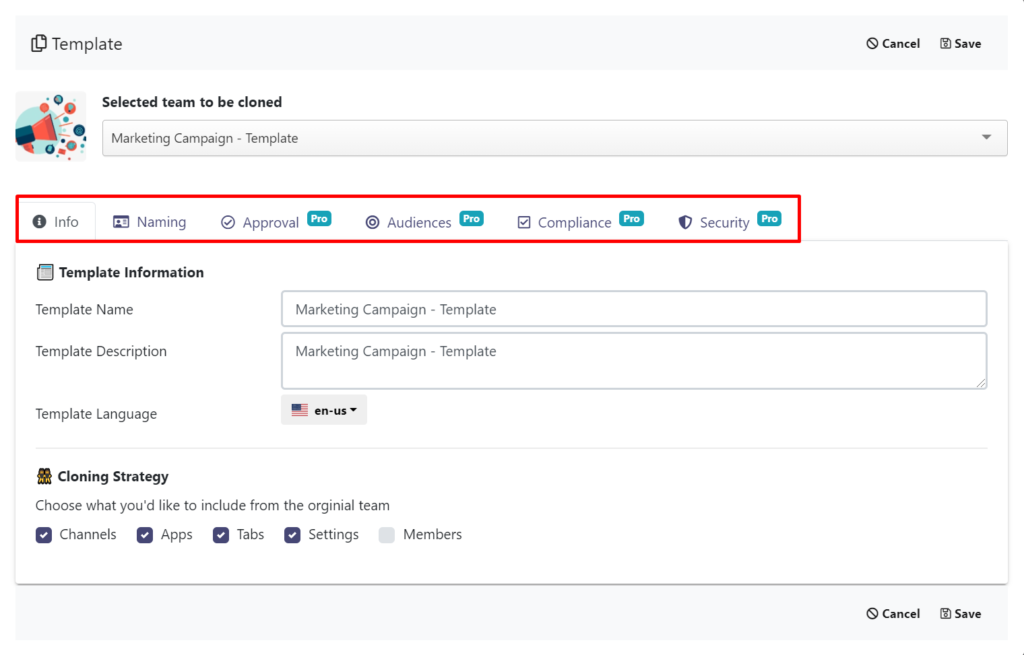
Your Marketing Campaign Microsoft Teams template is ready! Now, when your users want to create a team for a new marketing campaign, they’ll simply need to click on Home tab on the left navigation bar, then +New team and select the right template from the Template catalog. Once the team is created, all the content previously added at the template level will be automatically copied to it. You’ll get a fully customized ready-to-go team with all the necessary tools ready at place.
Want to know how Microsoft Teams Collaboration templates can address your business needs? Talk to our team and we’ll help you define your use cases and find the right solution.
